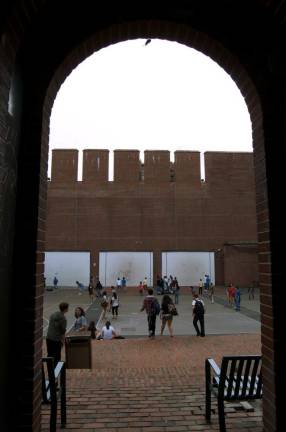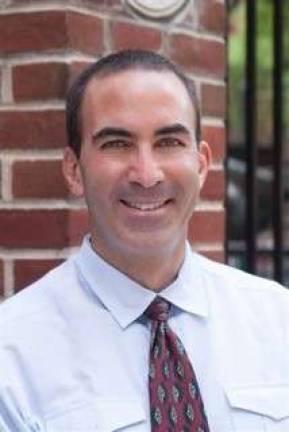A Troubled Reopening at the ‘Brick Prison’
At Hunter College High School, in-person schooling resumes, amid union clashes and a COVID flare-up


Hunter College High School usually makes the news for something more positive. The rigorous Upper East Side high school boasts the highest SAT and ACT scores in the nation, and has a long list of accomplished alumni, including Justice Elena Kagan, MSNBC anchor Chris Hayes and “Hamilton” creator Lin-Manuel Miranda.
But as New York public schools have faced a chaotic reopening process in the midst of the COVID-19 pandemic, Hunter has faced unique difficulties.
Hunter’s 94th Street building, which houses its elementary and high school, is an imposing fortress-like structure with only a few narrow windows. Many classrooms are entirely windowless, and the school is colloquially known as “The Brick Prison.”
In normal times, the building’s construction was the topic of lighthearted ribbing, but in this pandemic, where ventilation and circulation of fresh air is key to making indoor spaces safe, the lack of windows feels far more ominous.
Hunter is also unique in its administration. It is the only public school in the city not under the control of the Department of Education; instead it is governed by the City University of New York, as a part of Hunter College. Because of this, Hunter was not subject to the same reopening protocols as other public schools, instead reopening on a plan devised by CUNY.
“That’s always been a complication for us, that we’re not part of the Department of Education, we’re part of CUNY,” said Lori D’Amico, an English teacher, “and the pandemic has brought out the worst aspects of that position.”
The school’s initial reopening plan was immediately a point of controversy in the Hunter community. (This reporter is an alum of the school.)
“It was nothing that teachers, or faculty, or parents had involvement with,” said Cristina Moore, a math teacher and Professional Staff Congress union chapter chair.
D’Amico, who was serving as chair of the English department over the summer, was first informed of the plan in a mid-July meeting with the school’s department chairs, principal Tony Fisher and campus director Lisa Siegmann. Shortly after, teachers, then families were informed.
“It felt very top-down, we were being told the plan, instead of being included in the discussion,” Moore said.
The administration’s initial plan, which included the school’s proposed schedules for hybrid instruction, faced immediate criticism. A group of teachers called for a greater voice in crafting the school’s policies, and also demanded specific measures, including an independent inspection of the building’s airflow, installation of HEPA particle filters rather than less comprehensive air purifiers, and inclusion in the DOE’s random COVID testing plan.
Protests and Pushback
A petition calling for the teachers’ demands to be met quickly gained over 1000 signatures from both current students and alumni, circulating across social media.
“The teachers had voiced their concerns and the students heard them,” said 9th grade student Brian Chan.
A September 16 opinion piece in the New York Daily News by English teacher Danny Mozes criticized the reopening plan, writing “We’re giving this dumb plan an “F.”
Mozes also shared a personal story of how one of his colleagues, a longtime math teacher, was forced to retire after not being granted accommodations to teach remotely, despite the fact that her age would have qualified for one under the DOE’s guidelines.
Also on September 16, Hunter teachers with the PSC-CUNY union staged a protest outside the school’s 94th Street building to draw attention to their demands. As other CUNY-run campuses remain entirely remote, the union was able to focus its efforts on Hunter.
Even after the protest, petition and a letter-writing campaign from supportive families, the union’s demands remained unmet. Matters were taken to court, and on September 26, state Supreme Court Judge Eileen Rakower ordered the administration to install HEPA filters in every classroom before teachers could be ordered to return. Following a strike authorization vote by the union, CUNY also allowed for an independent inspection of the building’s airflow.
Although the results of the inspection were positive, the battle to have it take place in the first place “was just exhausting, mentally and physically,” said Moore.
The New Learning Landscape
Finally, in-person classes were able to begin on September 29, but not without difficulty. The school’s current plan allows for elementary schoolers as well as 7th and 8th grade students to have their in-person classes at the 94th Street building, while 9th and 10th grade students are taught at the Silberman School of Social Work on 119th street, and 11th and 12th grade students remain fully remote.
Chan, who has been getting used to learning at Silberman, says the new environment has been somewhat difficult to adjust to. “The school environment at Silberman feels like Hunter but it also doesn’t really feel like Hunter.”
Hybrid instruction, where a teacher must simultaneously instruct an in-person group and a group over Zoom, has also proven a source of frustration. “Our biggest issue is sound,” said D’Amico, explaining that between masks, social distancing, the noise of the HEPA filters, and the limitations of a Zoom setup, “it’s really hard, almost impossible for the kids at home to see and hear the kids in the room.”
“For a class like English,” she continued “which is traditionally discussion-based, it’s really hard to have a class that functions that way.”
Because of the confusion the back and forth between online and in-person activity can cause students, D’Amico said “I want to make sure what I do share with them is as clear as possible.” Because she is also the mother of two school-aged children, she said she understands the “logistical nightmare” of hybrid learning from both perspectives.
A Kindergarten Flare-up
Throwing another wrench in Hunter’s reopening was a flare-up of COVID cases among the school’s kindergarten. From October 14 to 16, two teachers and two students tested positive for COVID-19, prompting the school to close early for the week for deep cleaning.
“Clearly the protocols in place at the Hunter Campus Schools are not sufficient to prevent the spread of COVID-19,” said PSC president Barbara Bowen.
In their own statement to a New York Post article on the cases, Hunter’s administration stated “Our reopening plan met the highest health and safety standards and was approved under the CUNY guidelines all of which were much more stringent than the NYC Department of Education’s.”
While the DOE’s regulations call for a school to shut down in-person instruction should positive COVID tests emerge in multiple classrooms, the administration argued that a shutdown was not needed, as the two students who tested positive were in the same class “pod,” although said pods may be split between different classrooms.
On October 18, the union once again warned of a strike. If their safety demands, including pod separation and the providing of PPE, fail to be heard, “we will have to go back to that strike-authorization vote” said Bowen.
“Nobody wants to strike, everyone wants for things to be good, to be able to teach the students,” Moore said, but the school’s reopening protocol “has so many deficits.”
A strike, however, seems to have been averted, as in-person learning at Hunter resumed that week, and has since seen no reported COVID cases. Indeed, New York’s reopening of its public schools has been, on that front, a success, with only 28 COVID cases out of 16,348 students and teachers tested in the DOE’s testing program, a positivity rate about one tenth of that of the city overall.
But even amidst the tumult and anxiety of reopening, there is a sense of camaraderie among Hunter’s community. “What makes Hunter unique,” said Chan, “is how connected the students and teachers are to each other, and how we can push the administration for change.”